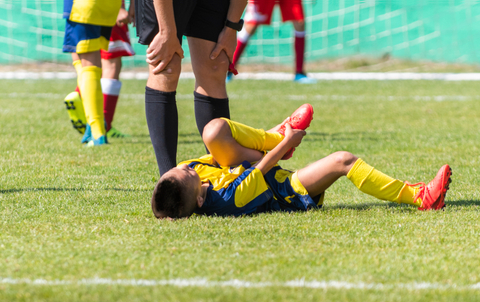
We all know the limitations of coaching in grassroots football, even if some coaches believe themselves to be the next Pep Guardiola. It is important to develop the player’s tactical understanding of the game though as this helps them to develop into better footballers and leads to a greater enjoyment of the game.
Coaching junior teams requires a blend of simplicity, adaptability, and creativity especially when dealing with players of limited technical ability and pitches that may not always be well suited to slick passing play. The key to effective coaching lies in making tactics comprehensible and easy to execute for grassroots players, ensuring that learning the game remains an enjoyable experience.

There simply isn’t the time in most grassroots set ups to begin to work on overcomplicated tactical set ups or in game phases of play. Often it’s simply a case of playing to your strengths with the players and conditions available to you at any one time.
As ever, formations often serve as the foundation of any tactical approach, providing structure and clarity for grassroots players. Just about every player will have built up an understanding of formations and the individual roles within them so it becomes quite straightforward for coaches to talk in these terms. Most people agree that with limited time to practice and develop tactics at grassroots level there is a lot to be said for K.I.S.S. – Keep It Simple Stupid.
Still a popular formation at grassroots level is 4-4-2 as it is effective and straightforward.
This classic setup offers a balanced distribution of players across the pitch, making it really easy for players to understand their roles and responsibilities.
The two lines of four provide defensive solidity while allowing for straightforward attacking options through the wide areas and two forwards.
This formation helps grassroots players grasp the basics of positioning and spacing without overwhelming them with complexity.
It is also really adaptable with the option of playing a possession based game or being more direct.
Another formation that often suits grassroots teams is 4-3-3.
This setup encourages attacking play and provides width, which is crucial for stretching the opposition and creating space.
The three midfielders can be arranged in various ways, such as a flat three or with one holding midfielder and two more advanced.
This flexibility allows coaches to adapt the formation based on the strengths and weaknesses of their individual players.
For instance, if a team has a particularly strong and disciplined midfielder, they can be utilised as the holding player almost as a hybrid centre back, providing cover for the defence while enabling the more creative players to push forward.
Pressing techniques are another vital aspect of junior football tactics and often miscommunicated. Teaching young players to press effectively involves instilling the principles of teamwork, communication, and anticipation. A simple and practical approach is to press in numbers when there is a trigger. This method encourages players to press the ball collectively rather than individually where they will get picked off, reducing the space and time the opponent has to make decisions. Winning the ball high up the pitch can lead to good counter attacking opportunities to score goals.
To implement pressing effectively, coaches can use drills that focus on small uneven sided games such as 5v3 or 8v6 matches in compressed spaces, help players understand how to work together to regain possession. Playing two touch encourages quick decision making and constant movement, replicating the conditions of a high pressing game. Additionally, incorporating scenarios where certain players are designated as the pressing leaders can help develop communication and leadership skills within the team.
Set-piece strategies are often overlooked but are an area where grassroots teams can gain a significant advantage. Set-pieces offer a structured and rehearsed opportunity to create scoring chances. Corner kicks, for example, can be simplified by designating key areas for delivery and specific roles for players. Free kicks in the attacking half can also be a valuable tool and coaches are at liberty to focus on developing a few reliable routines that players can execute confidently.
Keeping play simple is paramount when coaching grassroots players. Overcomplicating tactics can lead to confusion and frustration, detracting from the enjoyment of the game. Simplifying instructions and focusing on fundamental principles such as maintaining shape, passing accurately, and communicating effectively helps players build a solid foundation. For instance, when teaching defensive positioning, rather than delving into complex zonal marking systems, coaches can emphasise staying compact, tracking runners player-for-player, and pressing the ball as a unit.
Drills that reinforce these basic principles are invaluable. Simple passing squares for example, encourage accurate passing, movement off the ball and spatial awareness. By consistently practicing such drills, players develop a better understanding of the game's basic mechanics which stitch the game together and can be gradually built upon as their skills improve.
Adapting strategies to suit the abilities of your players and the conditions of the pitches they play on is another critical consideration. On less than ideal surfaces, where tight ball control might be a real challenge, there is nothing wrong with coaches focusing more on direct and effective play. There’s no point playing out if it merely means you turn the ball over in front of your posts. Encouraging players to use longer passes and capitalise on set-pieces can be more effective than attempting intricate passing sequences that are made impossible by poor pitches.
For example, when playing on a heavy pitch or one with long grass that doesn’t allow the ball to roll, playing forward into a physically strong forward to hold up the ball and bring others into play is effective. Coaches can train their team to support the target man quickly, creating opportunities for lay-offs and through balls that bypass the unreliable pitch conditions. Drills that simulate these scenarios, where players practice passing to a forward who then brings runners into the game can be highly beneficial.
Ultimately, the goal is to make the game accessible and enjoyable while instilling a tactical understanding that grassroots players can build on as they develop. Coaches should remain flexible, adapting their strategies to the strengths and weaknesses of their team and the specific challenges they face. By doing so, they not only improve their team's performance but also develop a deeper appreciation for the way it is played.

















